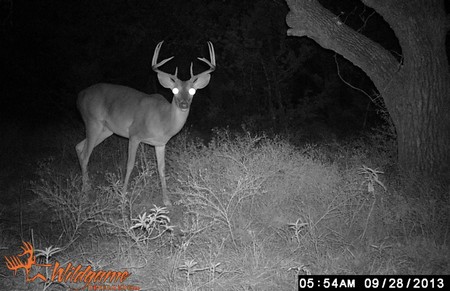Trail Camera Surveys 101
Trail camera surveys are a great way to management the deer on a property. Game cameras can be used to estimate the deer density, or tell you is how many acres you have per deer, i.e. density. Whitetail density is important because too many animals can cause habitat degradation and decrease deer hunting opportunities. The ideal whitetail deer density is different for every property, but ranges from 8 to 25 acres per deer, maybe even more depending on where the property is located.
A deer biologist can give you a good idea of the carrying capacity of your property. Once you have this information, surveys for deer become increasingly important. Once you know how many you SHOULD have you need to know how many you DO have. Trail camera surveys can help, but they will give you some additional data too. Game camera surveys also can estimate sex ratio, aka buck to doe ratio.

Source: How to Run a Trail Camera Survey
- Determine the number of cameras needed. On properties smaller than 1,000 acres, use one camera per 100 or fewer acres. On larger properties, use one camera per 160 or fewer acres. NOTE: If you can’t afford or borrow enough cameras, rotate the cameras you have across the survey sites until each site has been monitored 10 to 14 days. If you do this, be sure to start the cameras at the same sites at the same time each year and rotate to new sites in the same order each year to keep survey results comparable across years.
- Using a map or aerial photo of your property, mark off a grid that divides the tract into one block per camera needed. Select a camera site close to the center of each block based on ease of access and deer activity. (deer travel routes, woods roads, etc.). Identify each grid with a number or letter (placing a numbered or lettered sign at each site so that it will appear in the photos will help you later to organize images and data by location. See the photo above as an example).
- Clear ground-level debris at each camera site to allow for clean images of deer. Orient the camera facing north to avoid backlighting caused by sunrise or sunset.
- Locate the camera approximately 12 to 20 feet from the bait, with the bait pile in the center of the image. Precise set-up varies with camera model.
- With digital cameras, set the delay for no less than 5 minutes to keep the number of images manageable.
Analyzing Trail Camera Survey Data
Use game camera photos to survey the deer population using the site. A very accurate estimate of the total population and herd demographics can be obtained after identifying each individual buck, the number of times that buck was photographed, and the total number of does and fawns appearing in the pictures. Use the combined photos from all trail camera sites to give a good idea of the deer herd on the property.
Once the deer population has been estimated, then it’s time to put together a harvest management plan. Ideally, you should already have an idea of the carrying capacity of the property and a deer management plan, including the number of bucks and does that you want to over winter each year. For example, if your game camera survey estimates 20 bucks, 30 does and 10 fawns are on the property and you want to over winter 20 bucks and 30 does, then you need to shoot 5 bucks and 5 does (because half the fawns are male, half are female).
Once you are at the target deer population you will basically be removing the number of fawns that are produced each year. This is why keeping track of fawn numbers is important. Game camera surveys, like other surveys for whitetail deer, tend to underestimate fawn numbers, but this technique is one of the best ways to survey whitetail deer. Use trail cameras right and they can really take your management program and deer hunting to the next level.